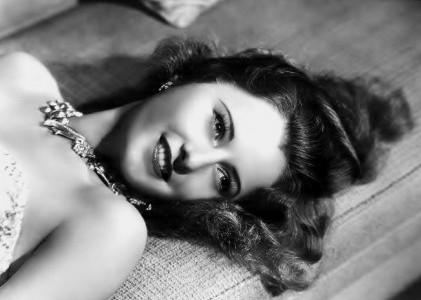All I Desire
This article is being published in conjunction with the retrospective Stanwyck at Film Forum in Manhattan, from December 6–31, 2013.
Barbara Stanwyck's film career spanned more than three decades, from the dawn of talkies to the crumbling of the Hollywood studio system. Through all those years, some things remain constant: her greyhound figure, her stripped-down acting style, her volatile mixture of hard shell and wounded heart. Wasting no effort, she brings to every scene the flexed focus of an athlete, an archer taking aim at the bull's eye. The arresting simplicity of her style speaks of inner resolve, a hard-won self-mastery that allows her to look at life without fear, though not without anger or sorrow.
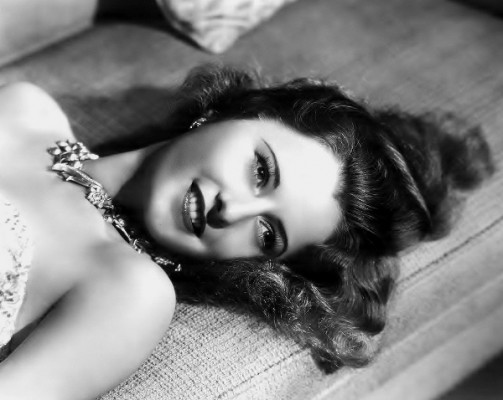
Barbara Stanwyck
With her famously lithe, bold stride, and her husky voice, at once so plain and so expressive in its effects, she was the archetypal American "dame." (This leveling word still carries traces of the honorific, like the similarly two-faced "lady," which appears in the titles of nine Stanwyck movies.) Perhaps because her toughness and intelligence were so natural, she didn't alienate audiences the way other strong female stars did; men loved her even as she duped, exploited, and occasionally plugged her male co-stars. She made every kind of movie, equally at home in comedy, melodrama, noir, westerns, period epics, and smash-and-grab pre-Code programmers. Equally at home yet, in some troubled and propulsive way, never at home.
In Stanwyck's movies, home is not a simple place. It is somewhere you return to with regrets (All I Desire), in disillusionment (Remember the Night), or in defeat (Clash by Night, in which she muses, "Home is where you come when you run out of places.") It is somewhere you are trapped and stifled, as she is in Double Indemnity, The Strange Love of Martha Ivers, and Crime of Passion. It's a place you run away from (Baby Face), or that you fear losing (No Man of Her Own). It's a place you don't have: Stanwyck played missionaries, card-sharps who live aboard ocean liners, and any number of rootless urban professionals whose homes, if they ever had any, are ancient history. Like other actor-auteurs whose careers were haunted by recurring, deeply personal themes, Stanwyck kept confronting the same dilemma on screen, that of a woman who can neither accept nor completely escape the things females are supposed to want: to settle and belong somewhere, to be taken care of and loved.
It is hard to resist tracing these themes back to Stanwyck's famously grim childhood, deprived of a stable home and family. She was born Ruby Stevens in 1907 in Brooklyn, and four years later her mother was killed in a streetcar accident. Abandoned by her father as well, she was shuffled through foster homes and the care of older siblings, a rough world of poverty and its attendant chaos. By her teens she was a chorus girl dancing in Manhattan nightclubs, and with fierce drive–not so much for wealth or success as, in her words, to "be the best of all"–she vaulted into stage roles and then movies, a consummate professional from the start.
Her first surviving film, The Locked Door (1929), screens on December 16 as part of Film Forum's Stanwyck retrospective, which accompanies the release of Victoria Wilson's new biography, A Life of Barbara Stanwyck: Steel-True, 1907-1940. A wave of interest in Stanwyck seems to have been rising since her centennial in 2007, another highlight being Dan Callahan's superb Barbara Stanwyck: The Miracle Woman (2012), which examines her films and performances in depth. Perhaps because she was so much less mannered and easily caricatured, Stanwyck has never had the cultural prominence of Bette Davis, Joan Crawford, or Katharine Hepburn, but a consensus may be building that she was in fact what she set out to be: the very best of all.
Rags and Riches: Pre-Code
All life is exploitation, a German cobbler tells a downtrodden young woman who toils as a barmaid and unwilling prostitute in her father's steel-town speakeasy. Quoting Nietzsche, he explains that the woman's attractiveness gives her power over men, and exhorts her in his Teutonic accent to "crush out all sentiment. Be strong, defiant! Use men-to get the things you want!" As his words sink in, she gazes unblinking into the future and breathes out a single, drawn-out syllable of comprehension: "Yeah..."
Baby Face (1933) is so sordid that even in the pre-Code era it was rejected by state censors and significantly altered before its release. (A print of the original, uncensored version was discovered in the Library of Congress in 2004 and debuted at Film Forum.) The effort was futile, since trying to clean up Baby Face is like trying to sweep up the sand on a beach. The Nietzschean cobbler was re-written as Jiminy Cricket, but nothing could be done about Stanwyck's performance as Lily Powers: about the flat, burnt-out disgust with which she surveys the speakeasy, where she is expected to put out for every randy steelworker and lecherous politician; or the look of icy satisfaction on her face as her father perishes in a still explosion.
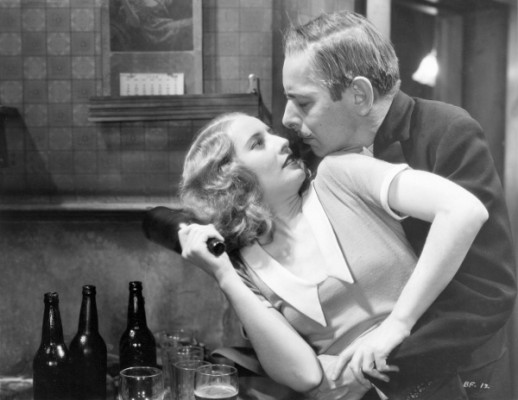
Baby Face, 1933
Lily's tale is a kind of filthy, female parody of the Horatio Alger rage-to-riches saga. She starts on the pavements in a frumpy cotton frock; climbs from one office job to the next sporting chic working-girl togs and a smart permanent wave; and winds up in a penthouse, swathed in furs and glittering backless gowns. Every step of the way is another man, seduced and discarded. Lily is scheming, greedy, and heartless; when one of her cast-off lovers shoots her sugar daddy and then kills himself, not a muscle moves in her face.
Yet far from asking us to pass judgment on her or to sympathize with the men she uses-a parade of weak-willed saps with only one thing on their minds-the film shamelessly revels in her exploits. A growling rendition of the "St. Louis Blues" accompanies her climb, which is conveyed with such telegraphic efficiency that the film achieves an exhilaratingly witty, insolent style. Baby Face has all the kick, the shocking laughs, and the underlying bleakness that exemplify pre-Code movies.
A wounded fury festers behind Lily's defiant poise. Her own father started pimping her to his customers when she was fourteen, and she has forced herself into so many loveless and sullied transactions that in the end, when her husband asks her to sacrifice her money and jewels to save him from going to jail, she balks. "My life has been bitter, hard," she explains. "I'm not like other women. All the gentleness and kindness in me has been killed." No one could play this part better than Stanwyck, with her level, unwavering gaze; her sudden lashing rages; the enticing warmth that she could, chillingly, turn on or off at will.
On a roll throughout the pre-Code years, Stanwyck alternated between the flippant toughness of Warner Bros. programmers like Night Nurse (1931) and Ladies They Talk About (1933), and the richly crafted, emotionally open dramas she made with Frank Capra at Columbia. Ladies of Leisure, The Miracle Woman, Forbidden, and The Bitter Tea of General Yen–photographed by Joseph Walker with a luminous, breath-on-glass shimmer–elevated Stanwyck both as an actress and as a star. Capra (who was in love with her) showcased an undefended, painfully sensitive side of Stanwyck's persona, which would rarely be laid bare so fully again, but would always lurk under her stoic mask. This breakthrough spared her from monotone hard-as-nails typecasting.
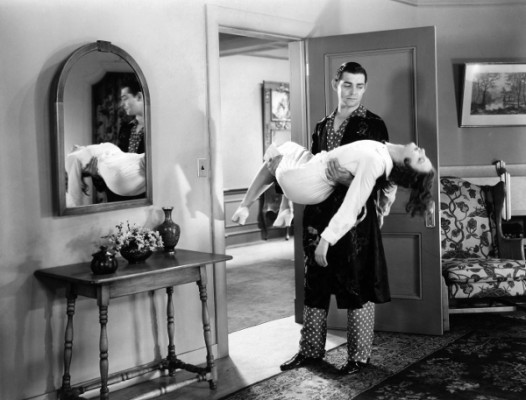
Night Nurse, 1931
That is not to deny the pleasure of watching Stanwyck as a glamorous bank-robber saunter around a women's prison (depicted, in Ladies They Talk About, as a sorority house for deviant gals), dishing out deadpan wisecracks and earning the fawning devotion of an upright evangelist–even after she shoots him in the arm. Or of Night Nurse, which goes beyond flouting the Production Code (set down in 1930, but largely ignored until 1934), and treats its proscriptions as a checklist of items to include. Undressing scenes, drinking, adultery, explicitly depicted crimes, vigilante justice, cruelty to children, suggestive dialogue–it's all there, along with Clark Gable socking Stanwyck on the jaw, and Stanwyck in her underwear hopping into roommate Joan Blondell's bed. Where the Capra films are cooked slowly, layered with strange flavors, transcendent scenes, and embarrassing flaws, flicks like Night Nurse are like wheat cakes flipped hot off the griddle. From the outset of her career, Stanwyck proved that she could both dish it out and take it.
Crooked but Never Common: Comedies
In the early thirties, comedy had a way of infiltrating other genres, much as noir did after World War II. Plots that turn on crime, desperation, injustice are heavily garnished with laughs; the humor is often as dark as the drama. After the Hays Code crackdown of 1934, the boundaries became stricter. The decade that followed was the summit of Hollywood romantic comedy, but Stanwyck mostly got the dregs of it: things like The Mad Miss Manton (1938), which miscasts her as a dizzy Park Avenue debutante and works doggedly to maintain a giddy screwball tone, coming off as flat as a bad singer or last week's champagne. Just before the war ended this era, Stanwyck finally made one great comedy, and two very good ones, working with masters of the form: Preston Sturges, Billy Wilder, and Howard Hawks.
In these films she's not called on to be silly, or to milk dumb gags; they make use of her observant sharpness and her reserve of deeply felt experience, pairing her perfectly with more naïve and ingenuous men. This dynamic–woman as hardened, wised-up, unscrupulous; man as innocent, idealistic, gullible–resonates throughout the thirties, in Capra's films (including his last with Stanwyck, the disturbing, awkward Meet John Doe) as well as in screwball comedy. It carries on the Depression-era sense of women as morally compromised survivors, which would resurface in the postwar figure of the femme fatale. With its sneaky imagery of snakes and apples, The Lady Eve (1941) rings every change on the theme of a knowing woman enticing her still innocent mate-and destroying him. "I need him like the axe needs the turkey," Stanwyck mutters darkly, and though it's a laugh line, in these comedies words draw blood.
Stanwyck wasn't the first choice to play the delightfully named Sugarpuss O'Shea in Ball of Fire (1941), but the role fits her as snugly and flatteringly as the spangled dance costume she wears. Howard Hawks directed the film but puts little imprint on the Charles Brackett-Billy Wilder script, with its lavish hodge-podge of slang and faux-intellectual verbiage. Parts of the movie verge on the cartoonish, and Gary Cooper is never very convincing as a brainy nerd, but Stanwyck cooks. Buoyant, streamlined, and sexy, she's like the human embodiment of swing music. She may be lip-synching her musical number, "Drum Boogie," (the singer is Martha Tilton), but she owns it; as an uncredited Elisha Cook, Jr., says, "She jives by night." It's a treat to watch Stanwyck have so much fun and show off her moves. (In the otherwise lackluster Lady of Burlesque [1943], she throws herself into a Lindy Hop that would have passed muster at the Savoy.) "I never had anybody move in on my mind before," Sugarpuss says when she shows up to tutor Cooper's Professor Potts on current slang, and despite jokes about how uneducated she is, Sugarpuss always comes across as the smarter of the two. When she predictably falls for the stuffy Potts after playing him for a sucker, she has no trouble making us believe in her remorse and reformation because she is, as always, a person of substance.
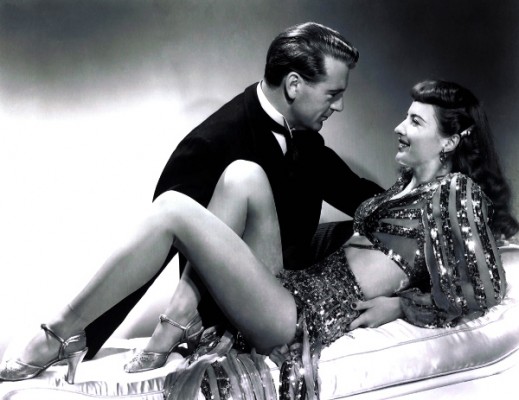
Ball of Fire, 1941
No one understood Stanwyck better than Preston Sturges: he got her gravity and her energy, her dryness and her wellsprings of emotion, her marksman's focus, and her bold simplicity. It was Sturges who promised to write her a great comedy after seeing her in Remember the Night (1940), which Mitchell Leisen directed from Sturges's script. He made good on his word a year later, but the brilliance of The Lady Eve should not dim the softer glow of Remember the Night, which Film Forum will run for a week between Christmas and New Year's. Stanwyck plays Lee Leander, a polished thief who is brought to trial by a crafty yet decent D.A. (Fred MacMurray). He gets her trial postponed so she won't be acquitted due to the soft-heartedness of Christmas-season juries, then feels guilty about stranding her in jail over the holiday and takes her along to his old Indiana home. They have some comic adventures, as when they're arrested and Lee, after giving her profession as "bubble dancer," effects their escape by starting a fire in a wastebasket. But the movie has a surprisingly dark heart, which emerges when they arrive at Lee's old home for the coldest of welcomes from her unforgiving mother. This is the most harrowing of all Stanwyck's homecoming scenes; it cuts to the bone like a cold winter night. The throb of pain returns at the end of the film, with the D.A.'s realization that he must prosecute the woman he now loves. These sorrowful shadows balance the film's warm-taffy sentiment and light comedy.
The Lady Eve is one of those movies that hits the bull's-eye so continuously that it seems one can only respond either with awed silence or by calling attention to every scene, line, character, and moment. It is one of the best and most ruthless expressions of a great American theme, the eternal conflict between the chiseler and the "sucker sapiens;" as well as of the enduring romantic comedy premise that disillusionment, deception, and betrayal pave the way to love's ultimate triumph. The film's success relies even more on the excellence of its leads than of its script: it is due to Stanwyck and Fonda that we can be happy to see their characters united at the end, even after Fonda's "Hopsie" Pike has behaved like a blind, self-righteous prig, and after Stanwyck's card-sharp Jean Harrington has subjected him to a nightmarish series of humiliations. The stars' on-screen chemistry was such that it simmered even in The Mad Miss Manton, and here Fonda's woozy account of Hopsie succumbing to Jean's seductive wiles is so adorable that we never quite give up on him. It's delightful to know that Stanwyck and Fonda had trouble filming the chaise longue scene (in which Jean plays with Hopsie's ear, his hair, and his mind) because they kept laughing so much.
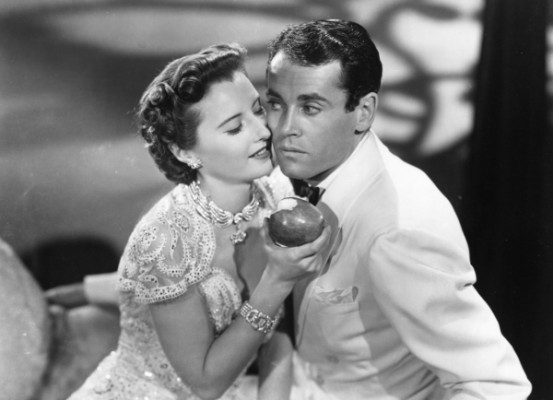
The Lady Eve, 1941
The Lady Eve has a special kind of barely-contained ebullience and lethal energy, like a cat playing with its prey. The touch of cruelty aligns with an attitude that runs through Stanwyck's films: a conviction that the world is divided into winners and losers, predators and victims. Yet The Lady Eve not only ends with a happy marriage between the two opposites, it reveals that Stanwyck herself contained both. There are moments when she's at her most narrow-eyed and calculating, and others at her most open-hearted and vulnerable; in all of them she is, in the definitive conclusion of William Demarest's Muggsy, "positively the same dame."
Fighting for Air: Film Noir
"Are you a mouse or an actress?," Billy Wilder challenged Stanwyck when she was reluctant to take the murderous role of Phyllis Dietrichson in Double Indemnity (1944), and of course she had to take the dare. Her courage was rewarded; film noir became one of her lifelines in the late 1940s and throughout the 1950s, allowing her to continue playing complex, attractive, forceful women at an age when many actresses got shelved as mothers. At the same time, her noir roles reveal the degree to which the postwar world had closed in on women; under the pressures of the Code and of repressively traditional postwar mores, noir films were deeply punitive toward women who step out of line. In film after film, Stanwyck's characters are frustrated by their circumscribed lives and plot to escape, resorting to both seduction and violence, usually ending up imprisoned or dead.
Even Phyllis Dietrichson, the most vicious woman she ever played, laments the trap of "security" she's fallen into, languishing in a tomb-like trophy house, strangled by "a leash so tight I can't breathe." Stanwyck recognized the oppressiveness of the Dietrichsons' "gloomy, horrible" home, saying that "you understood why she wanted to get out of there, away, no matter how." Bantering with Fred MacMurray's lecherous insurance salesman Walter Neff ("I wonder if I know what you mean." "I wonder if you wonder"), Stanwyck nails the type of woman who views her sex appeal from a detached and calculating perspective, deploying it blatantly yet as if by remote control. She was brave enough to wear a cheesy platinum wig, a tinkling anklet, and a tight white sweater that might as well have "You can sleep with me if you murder my husband" written across it; under the cheap glitter she's like a knife so sharp it cuts without pain.
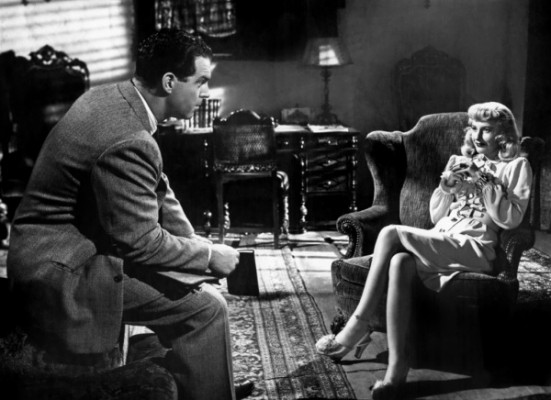
Double Indemnity, 1944
Sometimes in noir Stanwyck played against her usual assertiveness, creating disturbing portraits of female weakness and confinement. In the shrill, contrived Sorry, Wrong Number (1948), she's a bedridden hypochondriac so paralyzed by self-inflicted helplessness that she can't flee an assassin. In Witness to Murder (1956), she sees her neighbor (George Sanders) strangle a woman in his apartment, but can't get anyone to believe her, since she's middle-aged and unmarried, and hence assumed to be hysterical if not clinically insane.
As the title character in The Strange Love of Martha Ivers (1946), Stanwyck is the most powerful person in a small industrial city, and at the same time the most powerless, trapped forever by the consequences of a single childhood act. The film's four major characters spin a web of fear, greed and distrust, caught between the bitterness of the past and phantom hopes for the future. "Don't look back," Sam Masterson (Van Heflin) says, "You know what happened to Lot's wife." Indeed, Martha's frozen demeanor suggests a woman turning into a pillar of salt. She sees her chance for escape in Sam, a childhood friend who blows back into town to discover that Martha has been blackmailed into marrying Walter O'Neil (Kirk Douglas). Her husband knows her fatal secret, yet he's also an abject weakling whom Martha controls like a cruel hypnotist. (Douglas, in his film debut, is miscast to great effect; his virile presence brings a touch of perversity to Walter's plight; his frustrated love shades into masochism.) Stanwyck gives the film a core of impenetrable ambiguity: is Martha villain or victim? Perhaps both; she schemes and gloats in her power, yet cries that she's always been "so choked with wanting something else, with wanting air and room to breathe." In noir, Stanwyck often played women driven by the conviction that to get air, they need to smash all the windows.
In Clash by Night (1952), she shows how a woman might be not only frustrated by her options but irredeemably conflicted in her desires. As Mae Doyle, who returns to the fishing village of Monterey after seeking her fortune and failing to find it, she is a paradox. Walking into a bar with her suitcase and downing a mid-morning brandy, she's established as a hardened, experienced woman of the world. Yet she says, "I want to be looked after...I want a man to give me confidence." Seeking security and protection, she marries a kindly, dull fisherman (Paul Douglas) but finds herself so stifled with boredom as a housewife that she succumbs to an affair with her husband's churlish, misogynistic best friend (Robert Ryan.)
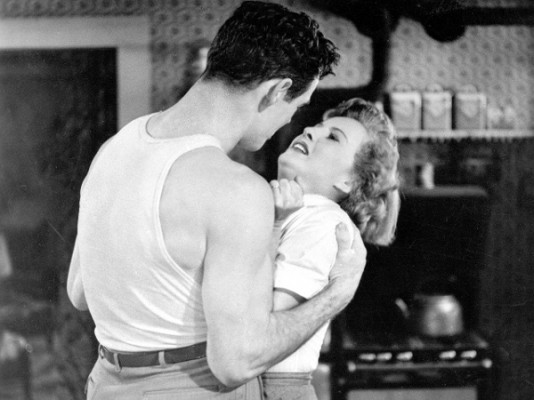
Clash by Night, 1954
Confined to a small kitchen in a stifling heat wave, Stanwyck and Ryan face off like caged tigers, both throbbing with unhappy, frustrated energy. Ryan towers over Stanwyck and manhandles her into a kiss, yet far from looking overpowered it's she who leaves the most scorching physical impression, shoving her hands into Ryan's undershirt and grabbing hungrily at his muscular back. As Monterey must have reeked of fish from the boats and the cannery, the film reeks of hostility between men and women; of jealousy, lust, resentment, disappointment. If they still seek each other, it's because "everyone is lonely, everyone is lost."
Amazing Tragic Stillness: Melodramas
In the two movies she made with Douglas Sirk, the best of all her melodramas, Stanwyck plays women contemplating the domestic lives they haven't had. In All I Desire (1953), a period drama, she's an actress who left her husband and children to go on the stage, and returns on a visit to face the resentments and regrets spawned by her absence. In There's Always Tomorrow (1956), she's an unmarried career woman who drops in on an old flame and finds him mired in a thankless and thwarted family life. These black-and-white films are far from the stylish excess of his Sirk's better-known color melodramas (Written on the Wind, Imitation of Life). Their plots, characters, performances, and directorial focus are all scaled to real-life emotions and relationships, yet they also have a distinctive classical grace to their structures and scenes.
Sirk called All I Desire "that insignificant little picture," but he offered one of the best summations of Stanwyck's greatness, noting that "there is nothing, nothing the least bit phony about her ever. Because she isn't capable of it...And she is so discreet–she gets every point, every nuance without hitting on anything too heavily. And there is such an amazing tragic stillness about her at the same time. She never steps out of it and she never puts it on, but it is always there, this deep melancholy in her presence...She impressed me all the time as someone–what can I say?–someone who had really been touched deeply by life in some way."
Despite Sirk's dismissal, All I Desire is a wonderfully subtle, ambivalent film about the difficult negotiations between individuality and family ties. It neither paints Stanwyck's character, Naomi Murdoch, as a heroic free spirit nor condemns her as a selfish monster; it presents family life as neither idyllic nor miserable. Naomi is no great artist, but she is charismatic and unconventional, with too much energy to be easily satisfied. She can't help stirring up the embers of her marriage (Richard Carlson is fine as the buttoned-down husband she betrayed), or trying to win back her children, one of whom worships her, while one resents, and one simply doesn't know her.
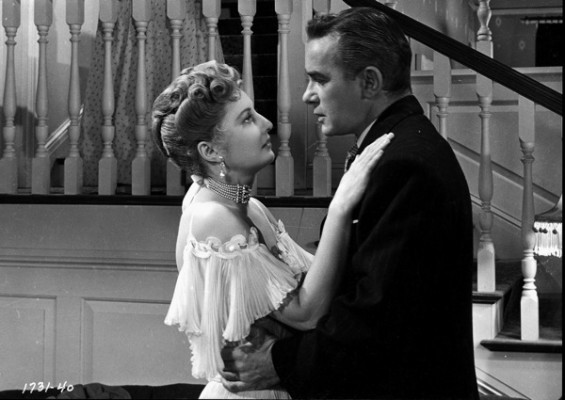
All I Desire, 1953
Stanwyck, who pulled out all the stops in Stella Dallas (1937), the ultimate mother-love weeper, here gives a complex and credible portrait of a woman who is not naturally maternal, yet finds deep bonds with her children as they reach the cusp of adulthood.There's Always Tomorrow takes a much more jaundiced view of families, expressing Sirk's scathing contempt for American teenagers (James Harvey calls him the anti-Nicholas Ray in this respect). The film is remarkable for portraying suburban domestic life as a stifling cage not for women, but for men. Fred MacMurray is moving as Cliff Groves, a husband and father who realizes that his shallow, self-absorbed wife and children are barely aware of his presence even as he toils to support them. The fact that MacMurray was the quintessential sitcom Dad (in My Three Sons) makes his baffled, frustrated loneliness all the more affecting. "I suddenly felt desperate, sitting in my own living room," he muses, "Like I was trapped in a tomb of my own making." Wearing a flowered apron that advertises his emasculation, he answers the doorbell to find Stanwyck's Norma standing outside, a figure from his past who seems to offer escape.
Though she is not the movie's central focus, Stanwyck is focused as a laser beam, cutting through the story with that devastating, face-up-to-it honesty that was her trademark. She's a woman who has come to terms with her loveless life, and she nixes Cliff's fantasy of a second chance-baldly telling him that it's too late-while also forcing his selfish, judgmental children to see how little they understand adult problems and feelings. With some obvious symbolism and its heavily ironic title, There's Always Tomorrow lacks the subtlety of All I Desire, but it is powerful in its bleak scrutiny of how disappointing even an apparently "successful" life can be, how getting older means slipping into a routine, facing one's limitations and mediocrity. As Cliff's wife, Joan Bennett plays a role that Stanwyck, for all her range and skill, could probably not have carried off: a complacent and self-satisfied woman whose inability to see how unhappy her husband is becomes a kind of horrible power. If there was one thing Stanwyck couldn't play, it was that kind of insulation from the truth, that happy ability to not be deeply touched by life.
"She Commands and Men Obey": Westerns
Stanwyck was the only woman of her time who really operated as a star of westerns, a genre in which women rarely feature as more than peripheral love interests or endangered pawns. Brooklyn-born Stanwyck loved ranches, horses, and westerns, and seems to have harbored romantic attitudes about the Old West, yet her best entries in the genre, like Anthony Mann's The Furies (1950), energetically dig up the ugly darkness buried under frontier myths.
Niven Busch supplied the original story for The Furies, giving free rein to his love of Greek tragedy and operatically heightened conflicts. The battle of wills between a ranch-owning patriarch and his equally domineering daughter also reflects Mann's obsession with revenge dramas and King Lear. As Vance Jeffords, Stanwyck never shies away from her character's spoiled willfulness and overweening pride, nor from the motherless Vance's near-incestuous attachment to her father, T.C. (Walter Huston). Nonetheless, Vance is sympathetic both in her frustrations–as an imperious woman who sees herself shunted off the ranch that has been promised to her, and that she is fully capable of running–and in her redeeming loyalty to the Hererras, a family of Mexican squatters who have lived on the Jeffords' land by age-old consent.
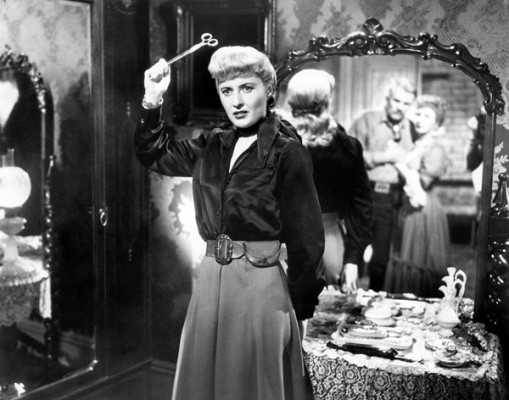
The Furies, 1950
Vance is perhaps the epitome of a certain type that Stanwyck often played: the strong, proud woman who is drawn to powerful men who overmaster her. Here, not only does her father throw her aside when he marries an urbane widow (Judith Anderson), but she is played for a sucker by Rip Darrow (a woefully miscast Wendell Corey), a gambler who uses her to recover a piece of land, leaving her humiliated. In this toxic battle of egos and greed, the one person who loves selflessly and sees clearly is the gentle Juan Herrera (Gilbert Roland), who quietly adores Vance. Their scenes together provide a delicate, sad undercurrent in an overheated, sometimes deliciously campy movie. (Stanwyck gets some catty dialogue worthy of Joan Crawford, as when a dance hall floozy says she's new in town and Vance retorts, "Honey, you wouldn't be new anywhere.") With a tit-for-tat escalation of cruelties, kicked off by Vance when she flings a scissors at her new stepmother's face, the film builds up a head of resentment and nastiness that the ending tries and fails to plaster over.
In 1957, the year she turned 50, Stanwyck starred in Samuel Fuller's delirious Forty Guns, not her last film but her swan song as a full-fledged, no-apologies movie star, before moving into supporting roles and television (including her long run in the western series The Big Valley [1965-1969]). The film ends on a dispiriting note, but Stanwyck gets an entrance that honors her with Fuller's trademark hyperbole: she gallops across the wide screen on a white steed, followed by the eponymous forty gunmen who work for her. She's mythologized by the film's theme-song as "a high-riding woman with a whip" who "commands and men obey." The song concludes that she is "only a woman after all," and the final scene has her running after the man (Barry Sullivan) who not only shot her–when her outlaw brother used her as a shield–but calmly walked over her body as she lay wounded in the street. Yet Stanwyck is never humiliated by the movie; she handles with dry, unflustered maturity the outrageous sexual innuendo that peppers the script, and the parade of problems that confront her powerful ranch-owner, Jessica Drummond. A wastrel brother, a right-hand man pining with unrequited love for her, financial problems, a tornado, a horse that drags her across the desert ground (Stanwyck did the stunt herself), a lover whose brother is killed by her brother-she takes it all in stride with the melancholy resignation of one who never thought life was supposed to be easy.
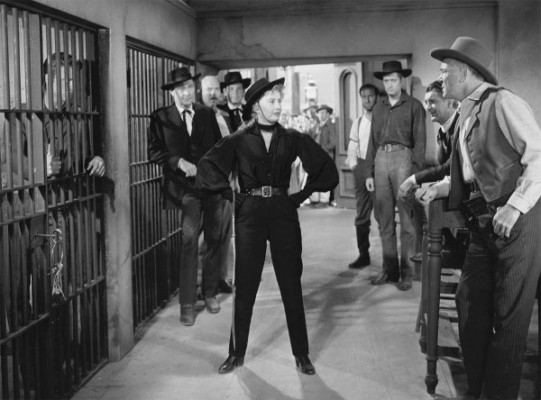
Forty Guns, 1957
Certainly Stanwyck never thought so. She fully understood the value of movies as dreams, as escape: in her wretched childhood she had lost herself in Pearl White serials, worshipping the intrepid heroine who always triumphed in the final twist. Yet she brought to movies a type of honesty–aimed not just at others but at herself–that seems as though it should have been incompatible with Hollywood's beautiful illusions. Movies were her true home, but she demonstrated, as so many of her screen characters did, that home is not where you are comfortable or safe or contented. Home is simply where you live.
![]()
LATEST ARTICLES
-20140814-173707-thumb3.jpg)
Fighting Words
by Imogen Sara Smith
posted August 12, 2014

Fighting Words, Part 2
by Imogen Sara Smith
posted August 20, 2014

On the Margins: The Fil…
by Andrew Chan
posted August 12, 2014

Robin Williams: A Sense…
by David Schwartz
posted August 12, 2014
 All I Desire
All I Desire
KEYWORDS
Barbara Stanwyck | Baby Face | Ball of Fire | The Lady Eve | Night Nurse | Ladies They Talk About | All I Desire | The Strange Love of Martha Ivers | Ladies of Leisure | The Miracle Woman | Forbidden | The Bitter Tea of General Yen | The Mad Miss Manton | Lady of Burlesque | Double Indemnity | Sorry | Wrong Number | Witness to Murder | Clash by Night | The FuriesFURTHER READING
Miracle Woman by Dan CallahanA Life of Barbara Stanwyck: Steel-True 1907-1940 by Victoria Wilson
THE AUTHOR
Imogen Sara Smith is a writer living in Brooklyn. She is the author of two books, In Lonely Places: Film Noir Beyond the City and Buster Keaton: the Persistence of Comedy
More articles by Imogen Sara Smith
